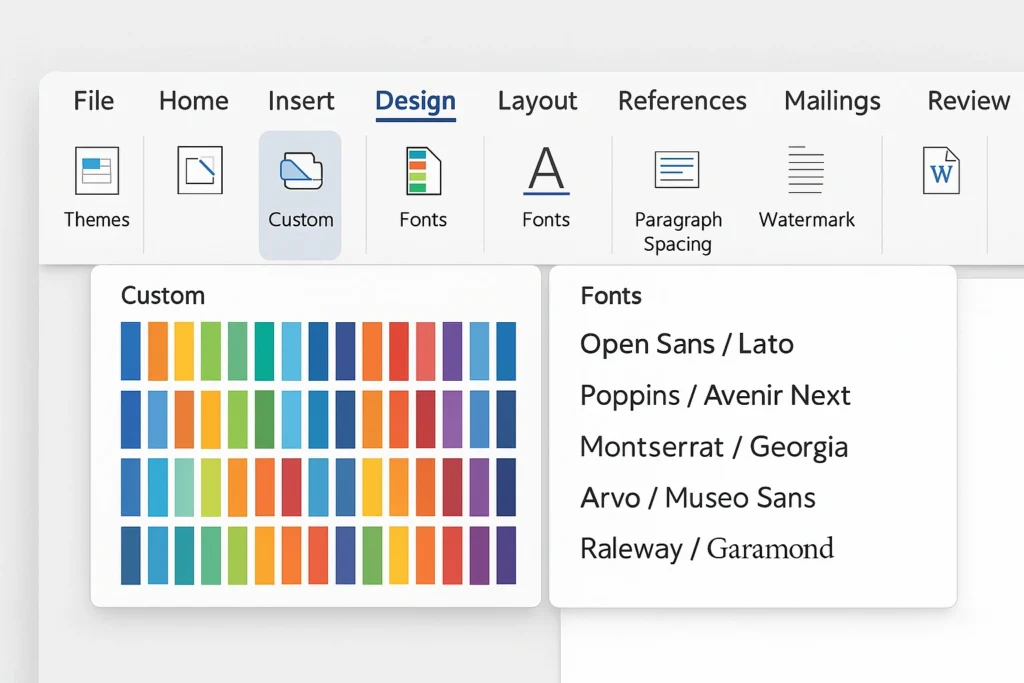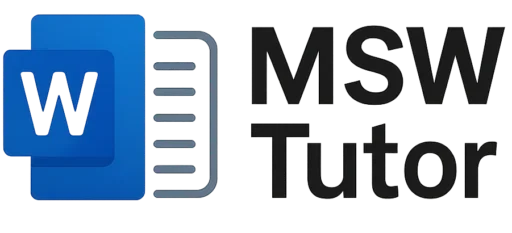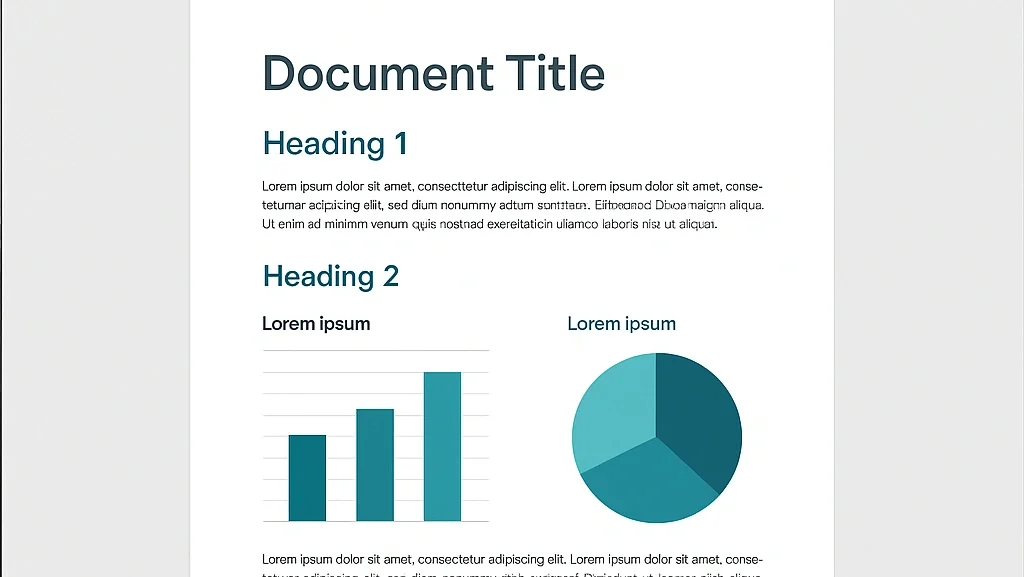Creating consistent, branded documents across an organization has become more crucial than ever in today’s competitive business landscape. With 85% of organizations having brand guidelines in place and brand consistency increasing revenue by 10-20%, Microsoft Word’s custom themes and style sets offer powerful tools to maintain your professional image effortlessly.
What Are Custom Word Themes and Brand Style Sets?
Microsoft Word themes are comprehensive design packages that combine coordinated colors, fonts, and graphic effects to create a unified document appearance. A brand style set, on the other hand, is a collection of formatting styles that maintain consistency in headings, body text, and other document elements while reflecting your company’s visual identity.
These tools work together to ensure every document your team creates maintains the same professional appearance, from business letters to comprehensive reports. When properly implemented, custom themes eliminate the need for manual formatting and reduce the risk of inconsistent branding across documents.
The Business Impact of Consistent Document Branding
Research shows that consistent brand presentation can increase revenue by up to 23%. Companies that maintain visual consistency across all touchpoints, including internal and external documents, see significant benefits:
- Enhanced brand recognition and trust
- Improved professional credibility
- Streamlined document creation processes
- Better team collaboration and efficiency through hands-free document creation using Word Voice Commands
Getting started with document templates provides your organization with a foundation for maintaining consistency across all communication channels. Additionally, building interactive forms with content controls complements your branding strategy by ensuring user-facing documents maintain the same professional standards while collecting information efficiently.
Creating Your First Custom Word Theme
Step 1: Access the Design Tab
Navigate to Word’s Design tab, where you’ll find the Themes gallery. This is your command center for creating and managing custom themes that reflect your brand identity.

Step 2: Customize Your Brand Colors
Click on Colors in the Document Formatting group and select “Customize Colors”. Here you can:
- Input your brand’s HEX or RGB color codes
- Define primary and secondary color palettes
- Set accent colors for charts and graphics
- Establish hyperlink and visited hyperlink colors
Professional tip: Most successful brands use a signature color that increases brand recognition by 80%. Ensure your custom theme incorporates these key brand colors consistently.
Step 3: Define Typography Standards
Select Fonts and choose “Customize Fonts” to establish your typography hierarchy. Create distinct pairings for:
- Heading fonts for titles and section headers
- Body fonts for main content
- Consistent sizing and spacing standards
Typography plays a crucial role in brand recognition, with 75% of consumers recognizing brands by their visual elements.
Step 4: Save Your Custom Theme
Once you’ve configured your colors and fonts, click “Save Current Theme” and give it a descriptive name. This creates a reusable theme file that can be shared across your organization.
Building Effective Brand Style Sets
Style sets take consistency a step further by defining specific formatting rules for different text elements. Here’s how to create them effectively:
Establishing Style Hierarchy
Create a clear hierarchy using effective headings and subheadings:
- Title style – Your main document heading with brand colors
- Heading 1-3 – Various section levels with consistent formatting
- Body text – Standard paragraph formatting
- Quote/Callout styles – Special emphasis elements
Implementing Brand-Specific Elements
Consider incorporating:
- Company logo positioning guidelines
- Consistent spacing and margins
- Branded header and footer elements
- Table and chart styling that matches your visual identity
Advanced Customization Techniques
Color Psychology in Document Design
Different colors evoke specific emotional responses. When creating your custom theme:
- Blue conveys trust and professionalism
- Green suggests growth and stability
- Red creates urgency and attention
- Gray provides neutrality and balance
Font Selection Best Practices
Choose fonts that reflect your brand personality while maintaining readability:
- Serif fonts (Times New Roman, Georgia) for traditional, formal communications
- Sans-serif fonts (Arial, Calibri) for modern, clean presentations
- Display fonts for headers that need visual impact
Integration with Other Microsoft Office Applications
Your custom themes automatically sync across Word, PowerPoint, and Excel, ensuring consistency throughout your entire Microsoft Office ecosystem.
Team Implementation and Management
Distribution Strategies
Share your custom themes effectively by:
- Saving themes to a shared network location
- Including theme files in team onboarding packages
- Creating documentation for proper usage guidelines
Training and Adoption
Successful implementation requires proper training. Consider:
- Creating video tutorials for your specific themes
- Establishing brand guidelines documentation
- Regular training sessions for new team members
- Designating brand champions within departments
Version Control and Updates
Maintain consistency by:
- Establishing a single source of truth for brand assets
- Regular auditing of document compliance
- Systematic updates when brand guidelines change
- Clear communication channels for brand-related changes
Troubleshooting Common Issues
Theme Compatibility Problems
When themes don’t display correctly:
- Ensure all team members use compatible Word versions
- Verify font availability across different systems
- Create fallback options for missing fonts
Maintaining Consistency Across Platforms
Address platform differences by:
- Testing themes on different operating systems
- Providing alternative color codes for web use
- Creating style guides for email and digital platforms
Advanced Features and Automation
Using Style Sets with Templates
Combine custom themes with professional templates to create powerful document creation workflows:
- Pre-formatted report templates with your branding
- Letter templates with consistent headers and footers
- Presentation templates that match your document themes, including professional form design features
Macro Integration for Enhanced Efficiency
Advanced users can create macros that:
- Automatically apply brand styles to imported content
- Insert company information consistently
- Format tables and charts according to brand standards
Measuring Success and ROI
Key Performance Indicators
Track the effectiveness of your branded document system:
- Time savings in document creation
- Brand compliance rates across departments
- Client feedback on document professionalism
- Team adoption rates of new systems
Continuous Improvement
Regular assessment helps optimize your approach:
- Quarterly reviews of brand guideline adherence
- User feedback collection and implementation
- Updates based on changing brand requirements
- Performance metrics analysis and optimization
Future-Proofing Your Brand System
Staying Current with Design Trends
2025 design trends emphasize:
- Maximum contrast for better accessibility
- Diversity and inclusion in visual representation
- AI-enhanced design practices
- Sustainable design principles
Preparing for Technology Changes
Consider future developments:
- Cloud-based brand asset management
- AI-powered design consistency checking
- Enhanced collaboration tools integration
- Mobile-first document creation workflows
Conclusion
Custom Word themes and brand style sets represent powerful tools for maintaining professional consistency across your organization. By implementing these systems thoughtfully, you can achieve the 10-20% revenue increase that comes with consistent brand presentation while streamlining your team’s document creation process. For enhanced document workflows, also explore our guide on Building Interactive Forms with Content Controls to combine visual branding with functional user interfaces and brand style sets represent powerful tools for maintaining professional consistency across your organization. By implementing these systems thoughtfully, you can achieve the 10-20% revenue increase that comes with consistent brand presentation while streamlining your team’s document creation process.
The investment in creating comprehensive brand systems pays dividends through improved efficiency, enhanced professional credibility, and stronger brand recognition. Start with basic color and font customization, then gradually expand to include more sophisticated style sets and automation features.
Remember that successful implementation requires ongoing commitment to training, maintenance, and continuous improvement. With proper planning and execution, your custom Word themes will become a valuable asset in maintaining your organisation’s professional brand identity.
Ready to transform your document creation process? Begin by auditing your current document library, identifying consistency gaps, and developing a comprehensive brand style guide that can be translated into effective Word themes and style sets.
Frequently Asked Questions
Q: How do I share custom themes across my organization?
A: Save your custom themes to a shared network location or include them in your organization’s template library. You can also email theme files (.thmx) directly to team members who can install them locally.
Q: Can I use custom themes with older versions of Microsoft Word?
A: Theme compatibility varies by version. While newer themes work in Word 2016 and later, some features may not display correctly in older versions. Test your themes across all versions used in your organization.
Q: What’s the difference between a theme and a template in Word?
A: A theme controls the visual design elements (colors, fonts, effects), while a template includes pre-formatted content structure. Themes can be applied to any document, whereas templates create new documents with specific layouts.
Q: How often should I update my organization’s custom themes?
A: Review your themes annually or whenever your brand guidelines change. Minor updates may be needed quarterly based on user feedback and evolving design trends.
Q: Can I prevent users from modifying the custom themes I create?
A: While you can’t completely lock themes, you can create detailed usage guidelines and provide training to ensure consistent application. Consider using document protection features for critical branded templates.
Q: Do custom Word themes work with other Microsoft Office applications?
A: Yes, custom themes created in Word automatically sync with PowerPoint and Excel, ensuring consistency across your entire Microsoft Office suite.
2 thoughts on “How To Create Custom Word Themes & Brand Style Sets In Word?”
Comments are closed.


Pingback: Building Interactive Forms with Content Controls & XML Mapping in Word | MSW Tutor.
Pingback: Microsoft OneNote for Students: Your Complete Study Companion | MSW Tutor.